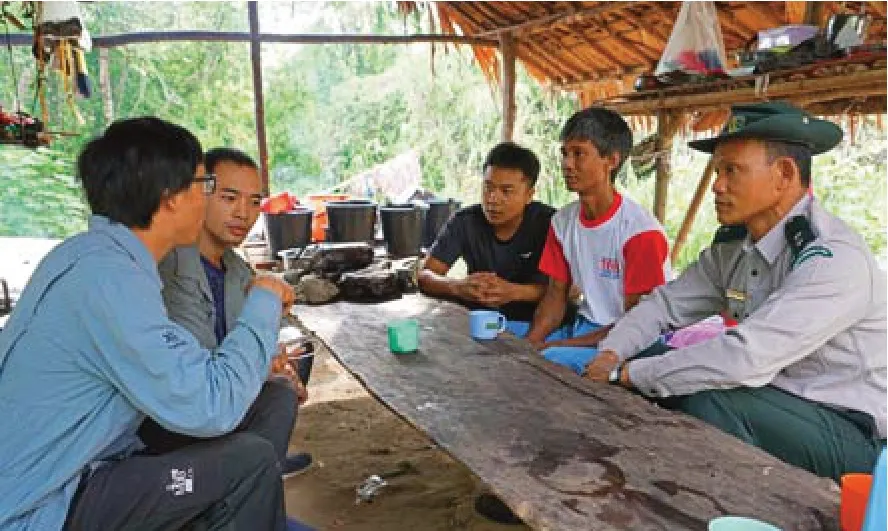TRACKING TIGERS IN MYANMAR A fruitful joint biodiversity field survey
By Li Ren, Xian Yijie

The eighth China-Myanmar Biodiversity Field Survey in the Htamanthi Wildlife Sanctuary in the Sagaing Region of northern Myanmar.
Compared to the rest of the global biodiversity conservation system, the tiger has undoubtedly attracted considerable attention. The National Tiger Action Plan for Myanmar has emphasized the key position of Htamanthi in northern Myanmar as a tiger migration corridor. However, local research on biodiversity has been meager, which has been a huge obstacle for conservation management and community sustainable development. Against this backdrop, the Southeast Asia Biodiversity Research Institute of the Chinese Academy of Sciences (CAS-SEABRI) worked with the Ministry of Resources and Environmental Conservation of Myanmar to carry out the eighth China-Myanmar Biodiversity Field Survey from May to June 2019.
On May 16, the China-Myanmar Biodiversity Field Survey Team arrived at Homalin Township on the edge of the Htamanthi Wildlife Sanctuary in the Sagaing Region of northern Myanmar. The township is located on the left side of the Chindwin River in a brutally humid subtropical and tropical savanna climate. Team leader Quan Ruichang, a researcher at the Xishuangbanna Tropical Botanical Garden (CAS-XTBG), met with Win Hlaing, an administrator of the Htamanthi Wildlife Sanctuary, to refine the itinerary of the field survey and expound on warnings for all researchers of the potential risks of Asian elephants and venomous snakes. After a grueling trek, the team arrived at the camp set up at a river basin protection station of the sanctuary.
On May 20, the survey team was split into two. One group was sent into the forest while the other ventured up the river in two small wooden boats. Only a few kilometers up the river, the researchers in one boat were pleasantly surprised to spot a strange animal hiding in the darkness ashore, only five or six meters from the boat. Researcher Ding Hongbo took some snapshots of the animal with his micro-lens camera before it vanished into the bushes.
After examining the vague pictures, researcher Quan was still not sure what the animal was. “It doesn't look like a water lizard because the cross section of its tail is round,” noted researcher Yang Bin. “The tail we saw was long and flat, more like a crocodile.” So far there are only 23 living species of crocodiles documented in the world. It would be amazing if a new species of crocodile was found in the freshwater ecosystem of northern Myanmar. Quan suggested the researchers work more on the sighting the next day.
At 9 a.m. the next morning, the survey team set off again
The China-Myanmar Biodiversity Field Survey Team on the way to the Htamanthi Wildlife Sanctuary in the Sagaing Region of northern Myanmar.in the two wooden boats. As they approached the location of the previous day's encounter, everyone became nervous and excited. But nothing was seen. “There it is!” exclaimed Yang Bin, who was perched at the bow. In the middle of the river a dozen of meters ahead of the boat was an animal swimming across with only a small part of its head and back above water. Soon enough, it rushed into the bamboo jungle on the other side of the river. Sadly, no better pictures were captured either. After evaluating the situation, the survey team decided to leave some researchers behind to watch for the “crocodile,” with equipment to capture it if necessary.

Members of the China-Myanmar Biodiversity Field Survey Team refine the itinerary for the field survey.

The China-Myanmar Biodiversity Field Survey Team on the way to the Htamanthi Wildlife Sanctuary in the Sagaing Region of northern Myanmar.
In the scorching heat at noon, researchers ducked into the shade of a big tree and concentrated their eyes and ears on the water's surface. The crackling and breaking of bamboo and trees by wild elephants in the distant forest could be heard. The wild animals in the valley seemed stuck at home due to the burning sun—only some white-breasted kingfisher (Halcyon smyrnensis) and white-crowned forktail (Enicurus leschenaulti) were still active on the other side of the river. As some researchers began to doze off, boat captain Kyaw Thu suddenly pointed at the trees on the other side of the river. An oriental pied hornbill (Anthracoceros albirostris) was picking the fruit of a banyan tree. Soon after the bird left, the top of the trees began shaking from a group of rhesus monkeys (Macaca mulatta), one of which eyed the team from behind the branches.
Unfortunately, the “crocodile” was never seen again. However, the survey was still very fruitful. The abundant nutrients and almost undisturbed natural environment make the sanctuary a paradise for aquatic animals. In some deep pools swam large schools of fish as long as 20 to 30 centimeters. A 15-centimeter-long eel with a row of sharp spikes on its back slipped onto the surface of the river with the strength of a snake. It took us quite a while to capture it. Its scientific name is Mastacembelus armatus, a species that can also be found in the water systems south of the Yangtze River in China. Over the following days, the team used food-trapping and traditional net fishing to capture specimens of more than 70 species of fish including the zig-zag eel.
The survey team also interviewed Kyaw Aung, a local hunter. On the relationship between man and elephant, he dubbed the Htamanthi Wildlife Sanctuary a harmonious environment for Asian elephants thanks to a large area of secondary forest providing them enough food and shelter. Upon hearing the crackling and breaking of bamboo and trees from wild elephants in the forest or seeing fresh elephant droppings, hunters go another way. As for tigers, across dozens of years of hunting in the mountains, he has only seen traces. Available information shows that the factors affecting the migration of tigers in Htamanthi and the surrounding areas are no longer the quality of the habitat. The team didn't find any traces of tigers during the field survey.
After nearly a month of surveying, the team collected more than 6,000 specimens of plants. Experts estimate about 1,500-2,000 species of plants in the sanctuary, but fewer than 500 species have been documented. A dozen new species of Orchidaceae, Compositae, Lauraceae, Fagaceae, Rubiaceae and Annonaceae may have been discovered. In terms of animals, two new species of fish may have been discovered. Pictures and videos of a variety of animals including orangutan and oriental pied hornbill (Anthracoceros albirostris) were obtained. To obtain more information on the diversity of animals, the team set up many infrared array cameras in the sanctuary.
In the years to come, more joint surveys will be organized to improve understanding of the biodiversity of the Htamanthi Wildlife Sanctuary, which will help relevant departments of Myanmar develop a scientific and reasonable protection action plan for conservation and sustainable development of the community that shares living space with tigers.
- China Report Asean的其它文章
- CHINESE, VIETNAMESE COMMUNIST PARTIES HOLD 15TH THEORY SEMINAR
- SEIZING SUSTAINABLE SOLUTIONS CHINA SETS THE STANDARD FOR ALLEVIATING POVERTY AND PROMOTING ONGOING GROWTH
- CHINESE VP MEETS MALAYSIAN DEPUTY PM
- 2019 CHINAASEAN EDUCATION COOPERATION WEEK
- NO PLANET B
- LI: MORE OPEN, TRANSPARENT, PREDICTABLE CHINA FOR FOREIGN INVESTMENT

